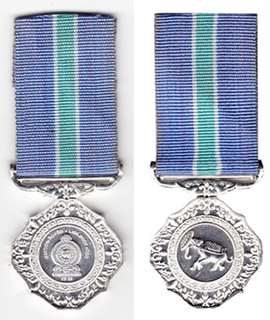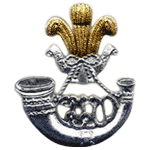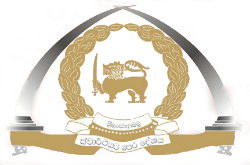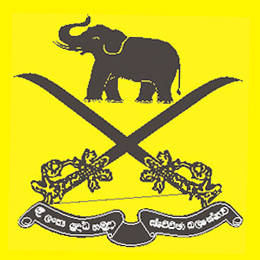The Ceylon Defence Force (CDF) was established in 1910 by the Ceylonese legislation Ceylon Defence Force Ordinance, which reformed the Ceylon Volunteer Force (CVF) that existed previously as the military reserve in the British Crown colony of Ceylon. At the time of forming it was only a reserve force but soon developed into a regular force responsible for the defence of Ceylon. The CDF was under the command of the General Officer Commanding, Ceylon of the British Army in Ceylon if mobilised. However mobilisation could be carried out only under orders from the Governor.

The Sri Lankan Army (SLA) is the oldest and largest of the Sri Lanka Armed Forces. Established as the Ceylon Army in 1949, it was renamed when Sri Lanka became a republic in 1972. In 2010, the Army had approximately 200,000 regular personnel, between 20,000 and 40,000 reserve (volunteer) personnel and 18,000 National Guardsmen and comprises 13 operational divisions, one air-mobile brigade, one commando brigade, one special forces brigade, one independent armored brigade, three mechanized infantry brigades and over 40 infantry brigades. From the 1980s to 2009 the army was engaged in the Sri Lankan Civil War.

The Sri Lankan Armed Forces award medals and their associated ribbon bars in recognition of various levels of service, personal accomplishments and commemorative events while a regular- or volunteer serviceperson is a member of the Sri Lanka Army, Sri Lanka Navy and the Sri Lanka Air Force. Together with military badges, such awards are a means to outwardly display the highlights of a serviceperson's career.

The Parama Weera Vibhushanaya is the highest decoration awarded by the Sri Lankan military, equivalent to the British Victoria Cross and the United States Medal of Honor. The medal is awarded to all ranks of the tri services, to both regular- and volunteer forces, in recognition of:
...individual acts of gallantry and conspicuous bravery of a non-military nature of the most exceptional order performed voluntarily with no regard to his own life and security with the objective of saving or safeguarding the life or lives of a person or personnel imperiled by death or for a meritorious act or a series of acts of a humane nature of an exceptional order displayed in saving life from drowning, fire and rescue operations in mines, floods and similar calamities under circumstances of grave bodily injury or great danger to the life of the rescuer...

The Weerodara Vibhushanaya is the second-highest decoration awarded by the Military of Sri Lanka awarded for:
...individual acts of gallantry and conspicuous bravery of a non-military nature of the most exceptional order performed voluntarily with no regard to his own life and security with the objective of saving or safeguarding the life or lives of a person or personnel imperiled by death or for a meritorious act or a series of acts of a humane nature of an exceptional order displayed in saving life from drowning, fire and rescue operations in mines, floods and similar calamities under circumstances of grave bodily injury or great danger to the life of the rescuer...

For the purposes of parading, the regular army & the volunteer force of the Sri Lanka Army is listed according to an order of precedence.

The Sri Lanka Armoured Corps (SLAC) provides the armour capability of the Sri Lanka Army, with vehicles such as the VT1A, T-55AM2, and ZTZ88 main battle tanks, the BMP infantry fighting vehicle and the BTR-80, and WZ551 armoured personnel carriers. It comprises six regular armoured regiments and a volunteer (reserve) regiment. It has an independent Armoured Brigade and is headquartered at Rock House Army Camp, Colombo.
The Sri Lanka Engineers (SLE) is a combat support arm of the Sri Lanka Army which provides military engineering. It is made up of ten regular regiments and one volunteer regiment. Headquartered at Army Cantonment, Panagoda, it is headed by the Centre Commandant.

The Sri Lanka Light Infantry (SLLI) is the oldest regiment in the Sri Lanka Army and the oldest infantry regiment in the army. It is made up of ten regular battalions and five volunteer battalions, and is headquartered at the Panagoda Cantonment, Panagoda. Over the years it has become the most distinguished and dependable regiment in the army.
The Gemunu Watch (GW) is a infantry regiment of the Sri Lanka Army, formed with troops from the Ceylon Light Infantry and the Ceylon Sinha Regiment in 1962. It has been deployed in many major operations against the LTTE. It is made up of 14 regular units and 9 volunteer units. Headquartered at Kuruwita Army Camp, Ratnapura. It is named after one of the most famous Lankan Kings, King Dutugemunu.

The Sri Lanka National Guard (SLNG) is the largest regiment in the Sri Lanka Army. It is a volunteer regiment currently made up of 20 battalions coming under the Sri Lanka Army Volunteer Force.

The Sri Lanka Army Volunteer Force (SLAVF) is the principal and volunteer reserve force component of the Sri Lanka Army. It is a collective name for the reserve units and the Sri Lanka National Guard. Sri Lanka Army Volunteer Force (SLAVF) being the oldest military organization in Sri Lanka, assisted the Regular Force for three decades in eradicating terrorism and currently employed its 55,000 + members deployed island-wide in supporting the Regular counterpart.

The Sri Lanka Army Medical Corps (SLMC) is a specialist corps in the Sri Lanka Army which specializes in military medicine and provides medical services to all army personnel and their families in war and in peace. It is made up of 4 regular units and one volunteer unit. Headquartered in Colombo, formally at army headquarters. The corps Cap badge depicting the Rod of Asclepius. General officers and senior officers of the SLMC wear gorget patches of maroon rather than of scarlet worn by other officers of similar rank.

The Sri Lanka Army Service Corps (SLASC) is a Combat Support corps of the Sri Lanka Army. The role of the corps is to carry supplies to the soldier where he is, and run an efficient organization for the provision of transport, fuel, oil and lubricants which are the 'life blood of an army’. It is made up of 7 regular units and one volunteer (reserve) units and is headquartered at its Regiment Center at the Panagoda Cantonment, Panagoda. The corps has a trade school in Anuradhapura which trains drivers, cooks and clerks for the Army.

The Sri Lanka Armed Forces is the overall unified military of the Democratic Socialist Republic of Sri Lanka encompassing the Sri Lanka Army, the Sri Lanka Navy, and the Sri Lanka Air Force; they are governed by the Ministry of Defence (MoD). The three services have around 346,700 active personnel; conscription has never been imposed in Sri Lanka. The Sri Lanka Coast Guard is also under the purview of the Ministry of Defence but is staffed by civilian personnel.
General Hamilton Wanasinghe, VSV is a Sri Lankan Army general. He served as the 11th Commander of the Sri Lankan Army (1988–1991), third General Officer Commanding (GOC) of the Joint Operations Headquarters (JOH) (1991–1993) and Permanent Secretary for Defense.

Colonel Candauda Arachchige Dharmapala, OBE, ED was Sri Lankan politician. He was a Parliamentary Secretary to the Minister of Industries, Housing and Social Services and Member of Parliament for Hakmana. He also served as the permanent secretary to the Ministry of Defence, and as Security Adviser to President J. R. Jayewardene.

Colonel (Col) is a senior officer rank in the Sri Lanka Army that is a superior rank to lieutenant colonel and subordinate to major-general. The rank has a NATO rank code of OF-6, equivalent to captain in the Sri Lanka Navy and group captain in the Sri Lanka Air Force.
The Ceylon National Guard (CNG) was a former Volunteer regiment of the Sri Lanka Army that existed from 1963 to 1980. The CNG was formed in 1962 as part of the reforms to the volunteer units in the Ceylon Army following the 1962 Ceylonese coup d'état attempt in which several volunteer units were implicated. The 2nd (Volunteer) Coastal Artillery Regiment, Ceylon Artillery and the 2nd (Volunteer) Signals, Ceylon Signals Corps were disbanded and personal from these units who were found to be not part of the attempt coup were re-grouped as the 1st Battalion, CNG and 2nd Battalion, CNG. The CNG was mobilized for duty with the Task Force Anti Illicit Immigration and during the 1971 JVP Insurrection. It was finally disbanded in 1980 after the 1st Battalion was transferred to the Sri Lanka Armoured Corps as the 2nd (Volunteer) Regiment, Sri Lanka Armoured Corps in 1979 and the 2nd Battalion was transferred to the Sri Lanka Artillery as the 5th (Volunteer) Regiment, Sri Lanka Artillery in 1980.












